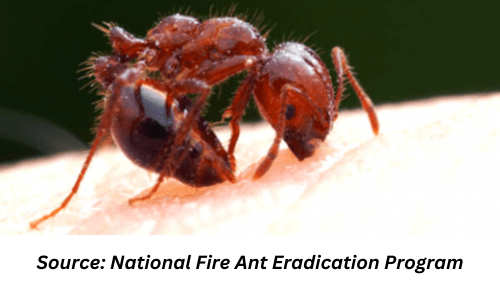Sandpiper June Blog: Fight Back Against Fire Ants
Infamous for packing a painful sting, fire ants are no joke. Fire ant infestations can get out of hand very quickly, as colonies can grow very rapidly, thriving in the sunny and humid conditions of Florida. Fire ants are not only a nuisance, but can also be a serious danger around your Indian River home.
The Serious Dangers of Fire Ants 
- While most ants only bite humans, part of the reason a run-in with fire ants is so
painful is due to the fact that fire ants both bite and sting.
- How is the fire ant able to both bite and sting its prey? Well first, the fire ant uses its pincer-like mandibles near its mouth to bite and hold onto its victim. Then, once the fire ant is locked on, the ant will use the stinger on its abdomen to pierce and attack, injecting their painful 95% alkaloid venom, as pictured above.
- A fire ant’s stinger isn’t barbed, which unfortunately allows one fire ant to sting multiple times during each encounter once they are clamped onto a victim. Usually, fire ants will keep repeatedly biting and stinging only until they are crushed or swatted off.
- If you have been unlucky enough to have a run-in with fire ants, then you may know that you are rarely able to escape with only one sting. This is another reason why encounters with fire ants can be so dangerous: they can coordinate attacks with one another.
- When fire ants feel threatened, they release an alarm pheromone out to other ants in the colony to alert them of the danger. When the other ants sense this alarm pheromone, they go rushing frantically toward the source to assist the ant putting the distress signal out, usually resulting in many painful, pesky stings.
Invasive to Florida
- There are two species of fire ants in Florida. Although there is the native fire ant (Solenopsis geminata), by far the most prevalent fire ant in Florida is the Red Imported Fire Ant (Solenopsis invicta), orRIFA.The red imported fire ant is an invasive species in the United States.
- Although originally native to central South America, these painful pests now can be primarily found throughout Southeastern states on the Gulf Coast, including Florida. They were first introduced into the United States at ports in Mobile, Alabama in the early 1900s via soil on ships from South America.
- Fire ants thrive in humid and warm conditions, making them a powerhouse in Southeastern Gulf Coast states. The RIFA is so invasive that it now occupies about 300 million acres throughout the United States.
How to Identify a Fire Ant Mound .2306051327550.png)
- How are you able to tell if an ant mound on your property is home to fire ants or another ant species?
- One of the key differences is that fire ant mounds do not have a visible, central entry hole like other anthills. Fire ants build their mounds out of soil. Fire ant mounds may look different in Florida compared to other places, depending on the amount of clay in the natural soil. Since Florida has very sandy soil, the fire ant mounds here appear as such. In areas with soil rich in clay, fire ant mounds appear more orange in color.
- Another difference between a fire ant mound and a regular ant mound is how they react when disturbed. Fire ants are notorious for reacting fast and aggressively when disturbed, whereas other types of ants react far less quickly, sometimes even not at all.
Sandpiper Pest Control’s Fire Ant Special
- If you are a homeowner seeking peace of mind and a safe yard this summer for your family and pets, don’t hesitate to contact Sandpiper Pest Control today for your FREE estimate! Sandpiper’s Top Choice treatment guarantees no fire ants for 1 year.
- We are offering a limited-time $100 off discount on our fire ant Top Choice treatment, so take advantage of this year-long protection while you can at a lower price!
- Click here to get your coupon $100 off fire ant treatment coupon from our website!

